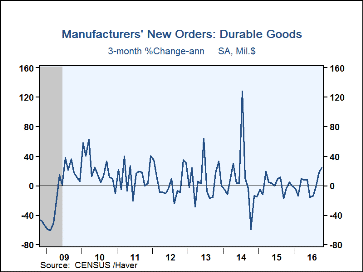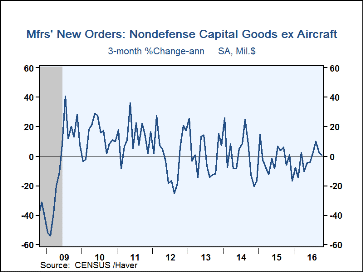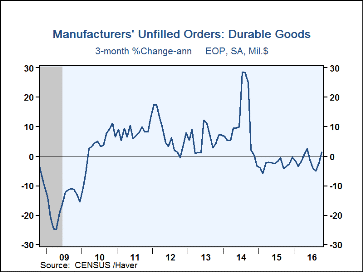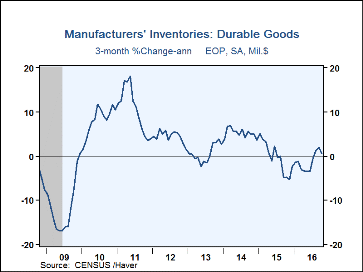 Global| Nov 23 2016
Global| Nov 23 2016Durable Goods Orders Surge in October, Mostly Civilian Aircraft
by:Sandy Batten
|in:Economy in Brief
Summary
Led by a 12.0% m/m jump in orders for transportation equipment, U.S. durable goods orders surged a much larger-than-expected 4.8% m/m (2.1% y/y) in October. The Action Economics Forecast Survey had looked for a 1.0% m/m increase. And [...]
Led by a 12.0% m/m jump in orders for transportation equipment, U.S. durable goods orders surged a much larger-than-expected 4.8% m/m (2.1% y/y) in October. The Action Economics Forecast Survey had looked for a 1.0% m/m increase. And the initially reported 0.3% m/m decline for September was revised up to a 0.4% m/m rise. The rise in transportation orders was due almost completely to a 94% m/m explosion of nondefense (civilian) aircraft orders. Nondefense aircraft orders rose $10.6 billion (SA) in October while total orders were up $11 billion (SA). Excluding defense and aircraft, orders edged up 0.3% m/m (0.6% y/y). While the October rise was modest, it was the fifth consecutive monthly increase for this key private-sector indicator, the longest string of monthly increases since the first five months of the recovery in 2009. Excluding transportation, orders rose 1.0% m/m in October (0.3% y/y, the first y/y increase since December 2014).
Core capital goods orders (nondefense capital goods orders excluding aircraft) rose 0.4% m/m (-4.0% y/y). After falling consistently during 2015, these orders appear to have bottomed during 2016, but nonetheless, remain lackluster, underscoring the general weakness exhibited by business investment spending in the national accounts. Core capital goods shipments, an accurate measure of the near-term course for business investment spending, edged up 0.2% m/m in October (-4.9% y/y) for its third consecutive monthly increase. Core capital goods shipments in October were 0.5% above the third quarter average--this indicator has declined in each of the preceding four quarters
Total shipments rose just 0.1% m/m (0.2% y/y) in October following an 0.8% m/m rise in September. Unfilled orders increased 0.7 m/m (-1.0% y/y) in October following four consecutive monthly declines. And inventories of durable goods were unchanged in October from September (-1.2% y/y) after three consecutive monthly increases.
The durable goods figures are available in Haver's USECON database. The Action Economics consensus forecast figure is in the AS1REPNA database.
| Durable Goods NAICS Classification | Oct | Sep | Aug | Oct Y/Y | 2015 | 2014 | 2013 |
|---|---|---|---|---|---|---|---|
| New Orders (SA, %) | 4.8 | -0.1 | 0.3 | 2.1 | -2.9 | 4.8 | 2.8 |
| Transportation | 12.0 | -0.8 | 0.6 | 5.2 | -4.0 | 6.8 | 8.8 |
| Total Excluding Transportation | 1.0 | 0.2 | 0.1 | 0.3 | -2.3 | 3.8 | -0.1 |
| Nondefense Capital Goods | 14.5 | 1.5 | -3.9 | 2.4 | -9.6 | 1.2 | 4.2 |
| Excluding Aircraft | 0.4 | -1.2 | 1.2 | -4.0 | -3.2 | 0.8 | 0.4 |
| Shipments | 0.1 | 0.8 | 0.0 | 0.2 | 1.1 | 3.5 | 2.8 |
| Unfilled Orders | 0.7 | -0.4 | -0.1 | -1.0 | -2.4 | 8.6 | 5.7 |
| Inventories | 0.0 | 0.1 | 0.1 | -1.2 | -0.6 | 5.2 | 1.0 |
Sandy Batten
AuthorMore in Author Profile »Sandy Batten has more than 30 years of experience analyzing industrial economies and financial markets and a wide range of experience across the financial services sector, government, and academia. Before joining Haver Analytics, Sandy was a Vice President and Senior Economist at Citibank; Senior Credit Market Analyst at CDC Investment Management, Managing Director at Bear Stearns, and Executive Director at JPMorgan. In 2008, Sandy was named the most accurate US forecaster by the National Association for Business Economics. He is a member of the New York Forecasters Club, NABE, and the American Economic Association. Prior to his time in the financial services sector, Sandy was a Research Officer at the Federal Reserve Bank of St. Louis, Senior Staff Economist on the President’s Council of Economic Advisors, Deputy Assistant Secretary for Economic Policy at the US Treasury, and Economist at the International Monetary Fund. Sandy has taught economics at St. Louis University, Denison University, and Muskingun College. He has published numerous peer-reviewed articles in a wide range of academic publications. He has a B.A. in economics from the University of Richmond and a M.A. and Ph.D. in economics from The Ohio State University.










